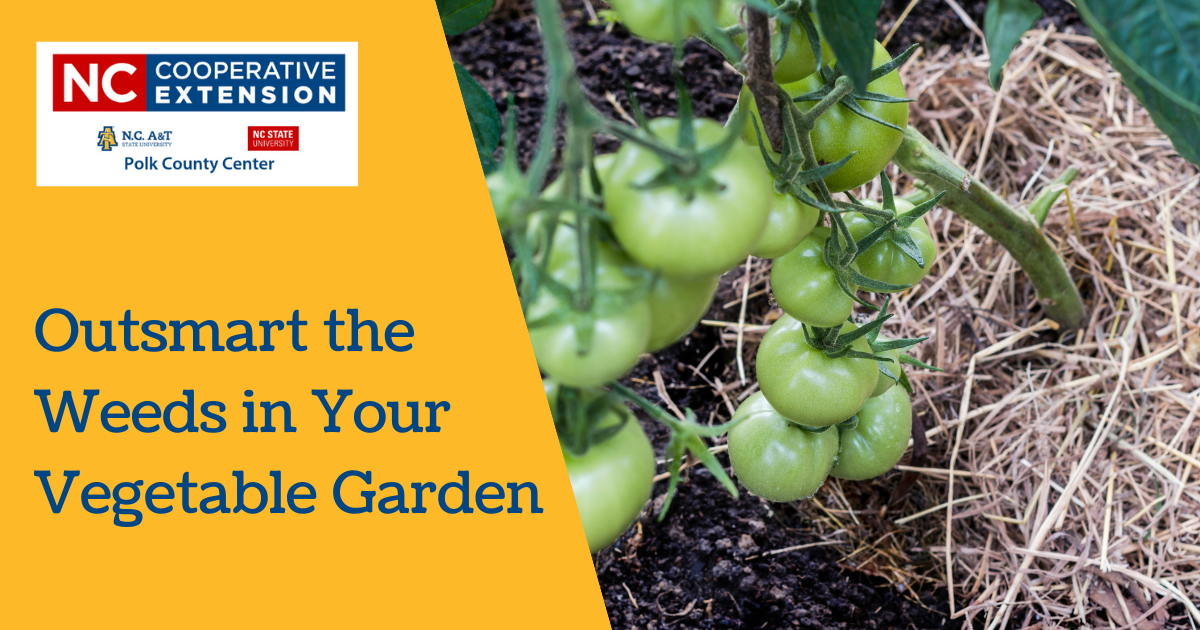Outsmart the Weeds in Vegetable Gardens
go.ncsu.edu/readext?799372
en Español / em Português
El inglés es el idioma de control de esta página. En la medida en que haya algún conflicto entre la traducción al inglés y la traducción, el inglés prevalece.
Al hacer clic en el enlace de traducción se activa un servicio de traducción gratuito para convertir la página al español. Al igual que con cualquier traducción por Internet, la conversión no es sensible al contexto y puede que no traduzca el texto en su significado original. NC State Extension no garantiza la exactitud del texto traducido. Por favor, tenga en cuenta que algunas aplicaciones y/o servicios pueden no funcionar como se espera cuando se traducen.
Português
Inglês é o idioma de controle desta página. Na medida que haja algum conflito entre o texto original em Inglês e a tradução, o Inglês prevalece.
Ao clicar no link de tradução, um serviço gratuito de tradução será ativado para converter a página para o Português. Como em qualquer tradução pela internet, a conversão não é sensivel ao contexto e pode não ocorrer a tradução para o significado orginal. O serviço de Extensão da Carolina do Norte (NC State Extension) não garante a exatidão do texto traduzido. Por favor, observe que algumas funções ou serviços podem não funcionar como esperado após a tradução.
English
English is the controlling language of this page. To the extent there is any conflict between the English text and the translation, English controls.
Clicking on the translation link activates a free translation service to convert the page to Spanish. As with any Internet translation, the conversion is not context-sensitive and may not translate the text to its original meaning. NC State Extension does not guarantee the accuracy of the translated text. Please note that some applications and/or services may not function as expected when translated.
Collapse ▲Reprinted from the NC State Extension Gardener newsletter archive.

With warm weather and rapid weed growth, many vegetable gardeners are reaching for hoes and spading forks. Gardeners can save labor by understanding weed life cycles and eliminating conditions that encourage weed growth (such as bare soil with excess nutrients). To outsmart the weeds in your garden, include practices in three categories of weed management:
1. Exclude weed seeds and propagules. Avoid bringing weeds into your garden by using only finished compost that has reached 140°F for a week or more, by using seed-free straw (rather than hay) for mulch, and by cleaning tools and equipment.
2. Use cultural practices to keep the soil covered and favor crops over weeds. Practice crop rotation. Vary when you till and plant because tillage stimulates weed seeds to germinate. To prevent summer annual weeds, establish an early spring crop. To prevent winter annual weeds, establish a long-season summer crop. Grow vigorous vegetable crops and manage them to outcompete weeds. Use ideal planting dates and transplants to help crops grow quickly and shade the soil. Test your garden soil and apply only the nutrients you need for healthy crops, as excess nutrients will encourage weed growth. Use drip irrigation or water at the base of your crops. Avoid watering between rows. Include cover crops in rotations. Cover crops are sown between cropping cycles to enrich the soil and suppress weeds (go.ncsu.edu/FCGHealthySoil). Once cover crops are cut down, the shoots can be used as mulch around crops.
Here are some tips on using cover crops to suppress weeds:
• Plant summer cover crops (such as millet and cowpea) in May or June to outcompete summer annuals and prevent germination of winter annuals.
• Plant overwintering cover crops (such as rye and hairy vetch) in the fall to outcompete winter annuals and to prevent germination of summer annuals the following spring.
• Cover crops can also suppress creeping perennials like bermudagrass or nutsedge. Till the soil to fragment the weed, remove as much as possible, and follow with a thick seeding of the cover crop.
3. Use mechanical practices to block weed growth and kill weeds at critical times. Use mulches to deprive weeds of light. In vegetable beds, straw or cover crop residue can control annual broadleaf weeds. In paths, landscape fabric topped with wood chips can suppress bermudagrass. Use hand-weeding, hoeing, or shallow tillage sparingly. Attack weeds when they are small enough to be killed by hoeing or shallow tilling. Avoid deep tillage, which brings weed seeds to the surface and damages soil structure.
With thoughtful planning, you can outsmart the weeds in your vegetable garden!




